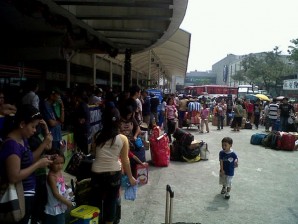There were two bus companies that plied the Quiapo - Diliman route: the JD Bus and the MD.
JD was a bit smaller and was colored pink and MD was bigger and was off white.
The JD conductress wore a crisp, (pwedeng tumayo dahil sa almirol) pink uniform, and MD employed male conductors who wore grey shirt and pants.
Those bus trips took about less than hour. Once the bus went under the Quaipo underpass and up onwards to Espana, you'd be in the Welcome Rotonda in less than ten minutes, and then on to Quezon Boulevard, on to the Delta Circle, and right onto the Eliptical Road.
Elliptical Road/Rotonda was a huge expanse of green grass and the the Quezon City Hall was an imposing structure. The U.P. Teacher's Village was a landmark, and when the bus turned right at the corner of Philcoa to the road leading the University, it was a wide, uncluttered lane.
 |
| Elliptical Road of yesteryear. |
Then you saw the U.P. Oblation and this freshman's heart was aflutter - tense on the very first semester.
Luckily, U.P. had the block system in force then, so we freshmen had the same classmates in all our classes, English 11, Math 11, Humanities 11, Spanish 11, etc. We only had classes leading to our major or specialization on our second/third years.
The buses plying Manila and towns off Manila were not air conditioned; the first air con bus came after Martial Law had been imposed, and it was called the Love Bus.
 |
| The Manila Love Bus, first rolled down Manila streets a few years after Martial Law had been declared |
So JD and MD had their windows wide open. I remember JD had those lawanit-type, pull down windows. I actually preferred the MD bus because it was bigger and had wider alleys so when there were no more seats available and you had to stand up, it was more comfortable.
Pickpockets were rare then, so passengers were more relaxed.
When our family car was not available and we had to go home to our home province, our family took either the Bautista Liner or the Baliwag Transit. The Bautista Liner ceased operation many years ago, but the Baliwag Transit is still robustly transferring commuters to many points in Central and Northern Luzon today.
Those Baliwag trips, though rare, were memorable. We usually clustered at the back of the bus, being a large family of ten, and one relative was a conductor, so he'd arrange for our seats in advance
Once, we went to Baguio and took the air conditioned Pantranco Bus at its terminal in Quezon City. I was with my aunt and two sisters and we had the late comedienne Dely Atay Atayan as co-passenger.
And right after Martial Law was declared, we travelled up Philippine north on a Pantranco bus, too, and had soldiers stopping the trip and inspecting the bus and passengers more than once. It was a scary ride.
In Jersey city, bus was my main means of transportation when I worked in Manhattan. I would wait at the corner of West side for the bus going to Journal Square where I transferred to the Path Train for the last stop at the World Trade.
When I moved to Sayreville, New Jersey, I had a daily bus commute from Jersey to 47th street, and then I'd walked up to 57th.
In Toronto, I rarely take the bus, but when I do it is the Metro wherein you paid one fare and included a transfer, either to the subway or another connecting bus ride.
 |
| Toronto Transit Bus bound for Warden in Scarborough |
Metro Toronto offers special discounted rates to students and you can purchase a monthly pass or a weekly pass which give more savings than daily tokens.
On a trip to the west coast recently, we took the Greyhound bus from Las Vegas to L.A., all five hours of it and stopped to eat at a Mexican resto featuring Filipino pancit and adobo.
 |
| Greyhound Bust stop at Barrow, CA |
Today Metro Manila has over one hundred bus liners jockeying up for thousands of Metro Manila passengers. Add to these those provincial buses and you'd get a nightmarish traffic situation, especially on holidays.
 |
| Holiday commuters at a Manila bus terminal |
During my youth, a cousin of mine who'd be going home to Nueva Ecija would wait in Balintawak for a Baliwag bus coming from the North, boarded it and travelled up to the terminal in Grace Park where his family was waiting for the trip back North.
Cubao has the most number of terminals, there's the Baliwag, Victory, and numerous others with provincial routes. Dangwa, a transport institution, still operates at its Laon Laan terminal and also known for its flower merchants, who peddle flowers from Baguio.
 |
| Flower shop at the Dangwa Terminal in Sampaloc |
There was a bus liner that travelled to southern provinces and had a terminal in Pasay, called BLTBCo. (Batangas Laguna Tayabas Bus Co.) wherein I took a bus going to Taal one time. It was the oldest bus company in the Philippines, having been founded in 1918 right after the first world war. It is now merged with another bus company.
At Commonwealth Avenue, the prevailing speed limit is 60 km/h. It was imposed because of many road accidents mainly caused by over speeding buses.









